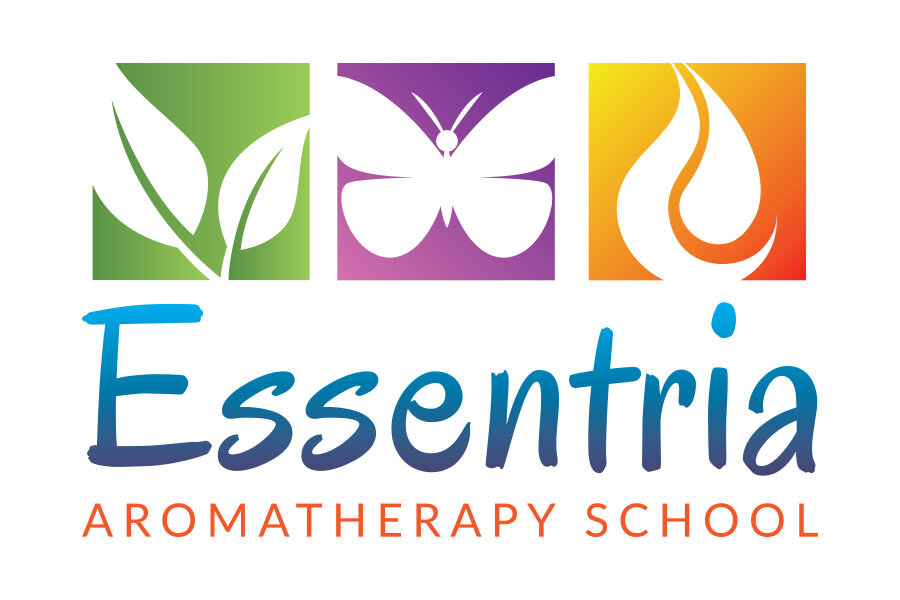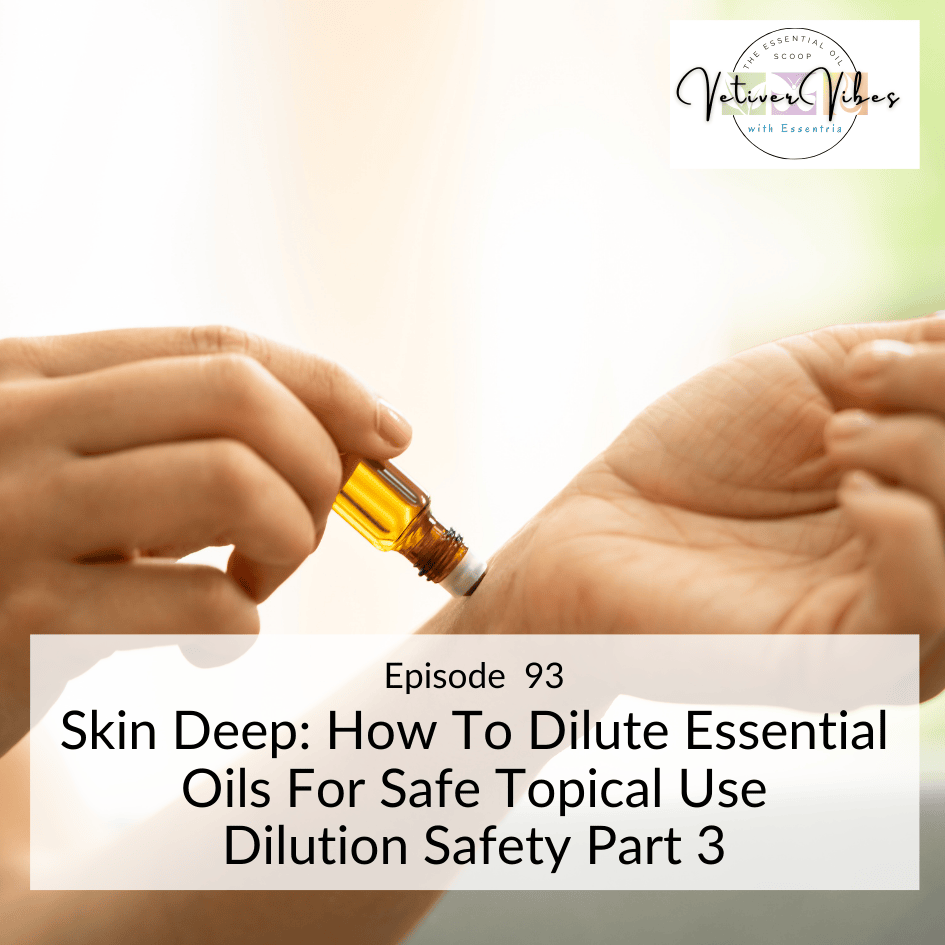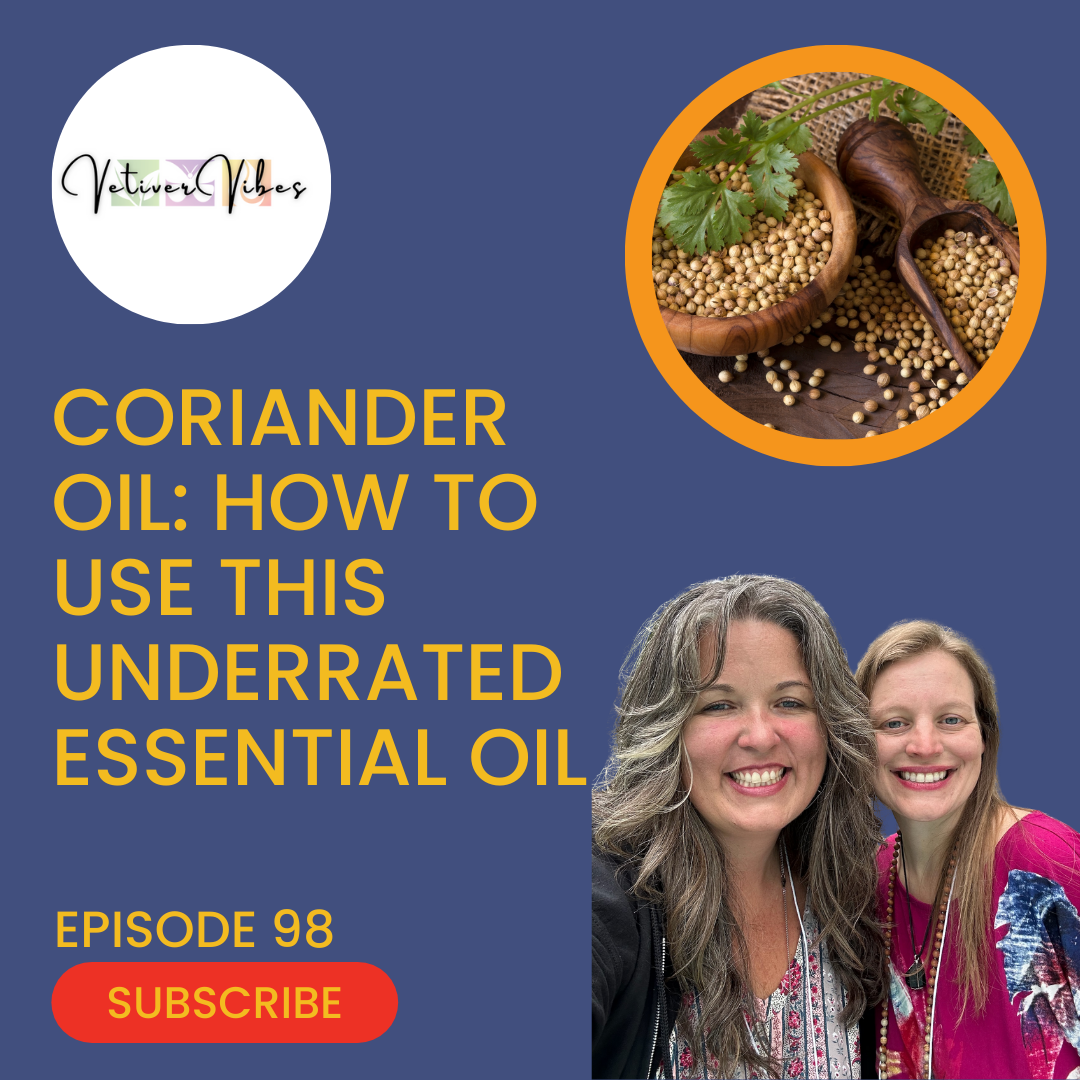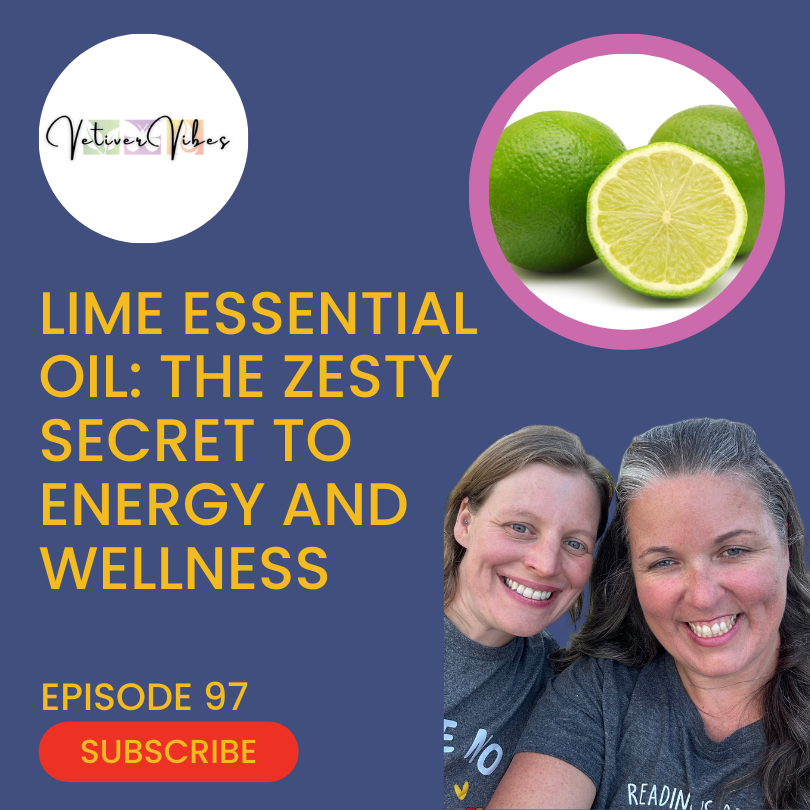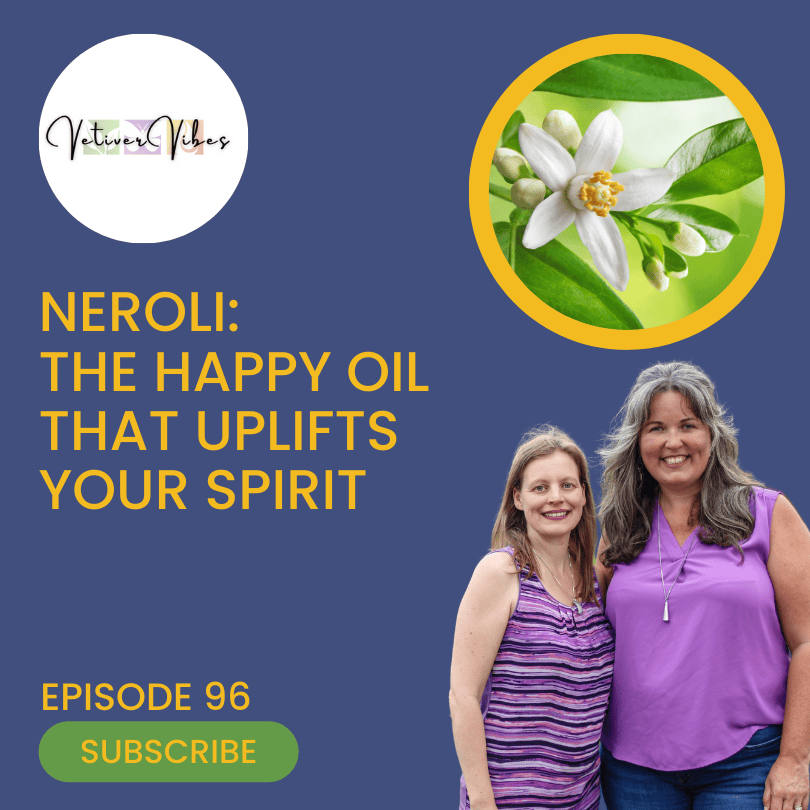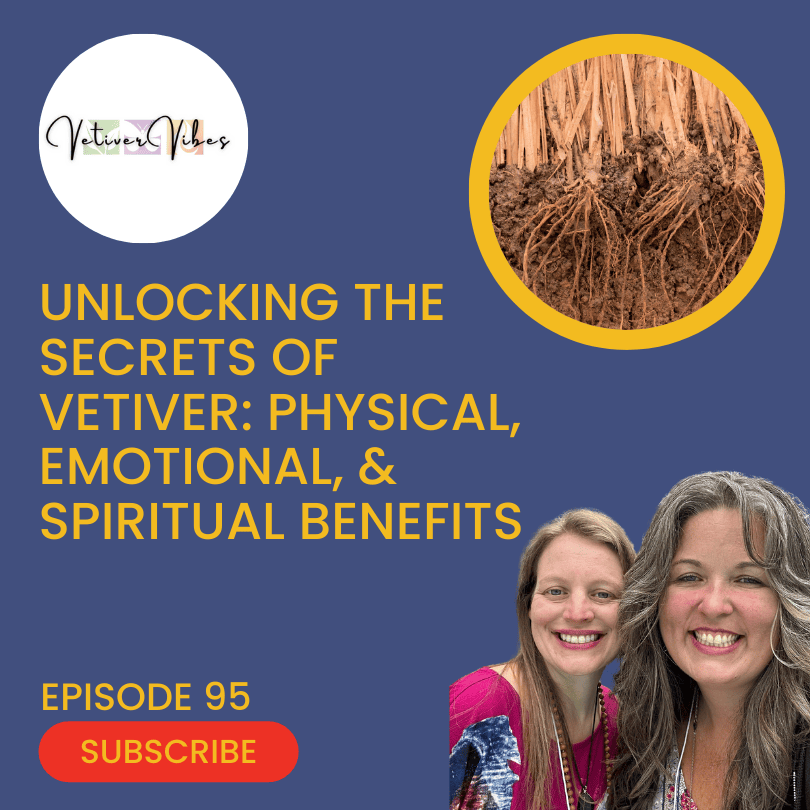Ep. 93: Skin Deep: How To Dilute Essential Oils For Safe Topical Use - Part 3
SHOW NOTES
In this episode of the Vetiver Vibes podcast, we dive into part three of our series on safety dilution, focusing specifically on dermal dilution and its importance based on where you apply essential oils on your body.
As Certified Clinical Aromatherapists, Rachael Dean and Nikki Fraser, are thrilled to share our insights and expertise to help you use essential oils safely and effectively.
We begin by discussing the significance of proper dilution, especially when applying oils to sensitive areas like the face. We recommend a dilution of 0.2% to 1.5% for facial applications, emphasizing the need for caution due to the delicate nature of facial skin. We also touch on the importance of avoiding essential oils near the eyes and suggest alternative remedies, such as herbal tea compresses for issues like styes.
Next, we explore the world of aroma massage, which is one of our favourite practices. We discuss the appropriate dilution rates for body massages, recommending a range of 1.5% to 3%. We share personal anecdotes about our experiences with aroma massage and how to adjust dilutions based on individual needs, particularly for clients with dry skin.
Moving on to body and bath applications, we highlight the importance of diluting essential oils in carrier oils before adding them to bathwater. We provide practical tips for creating your own bath blends, ensuring that listeners understand the necessity of proper dilution to maximize therapeutic benefits.
We then address specific issues such as dermal wounds and pain management, where higher dilutions of 4% to 10% may be appropriate for short-term use, not chronic conditions. We stress the importance of consulting with a clinical aromatherapist for guidance in these situations, as well as the need to start with lower dilutions and gradually increase as necessary.
Throughout the episode, we emphasize the principle of "less is more" when it comes to essential oil usage. We want our listeners to feel empowered to use essential oils safely, ensuring that they can enjoy their benefits for years to come.
As we wrap up this three-part series, we encourage our audience to revisit parts one and two for a comprehensive understanding of dilution principles. We are passionate about spreading the word on safe essential oil practices, and we hope you find this episode informative and helpful in your aromatherapy journey. Thank you for tuning in, and we look forward to sharing more insights in future episodes!
-
00:00:00 - Welcome to Vetiver Vibes
Introduction to the podcast and hosts, Nikki Fraser and Rachael Dean.00:00:14 - Sponsored by Essentria
Information about Essentria, an online school for aromatherapy.00:00:25 - Part Three: Safety Dilution
Overview of the episode focusing on dermal dilution based on application areas.00:00:57 - Free Dilution Charts
Details on where to find free dilution charts on their website.00:01:42 - Dilution for the Face
Discussion on safe dilution percentages for facial applications.00:02:23 - Using Essential Oils for Headaches
Exploration of applying essential oils for headache relief.00:04:17 - Caution Around the Eyes
Warnings about using essential oils near the eyes and alternative remedies.00:05:58 - Aroma Massage
Introduction to aroma massage and recommended dilution percentages.00:07:08 - Body and Bath Applications
Guidelines for diluting essential oils for body butters and bath salts.00:10:40 - Specific Issues and Pain Management
Discussion on higher dilution percentages for specific issues and acute pain.00:16:05 - Short-Term Use Guidelines
Emphasis on the importance of short-term use for higher dilutions.00:19:51 - Caution and Sensitization
Final thoughts on the importance of proper dilution to avoid sensitization.00:20:24 - Conclusion of the Series
Wrap-up of the three-part series on dilution and safety in essential oil use. -
Rachael: Welcome to the Vetiver Vibes podcast, where your hosts, Nikki Fraser and Rachael Dean, certified clinical aromatherapists. We are excited to have you here on today's episode, where you know that you'll get the best essential oil scoop.
Nikki: This episode is brought to you by Essentria a leading online school for aromatherapy. If you want to learn more about how to become a clinical aromatherapist, check out the courses at www.schoolofessentria.com Welcome to this week's episode of Vetiver Vibes. Nikki Fraser here with Rachael Dean. Hi. And we are part three of our safety dilution. So this week, we are talking all about dermal dilution, depending on where you are applying it on your body. So if you're on YouTube, I'm hoping this is showing up with the background.
Rachael: We'll edit it into the YouTube videos. Yeah. We'll make it easier for people to see.
Nikki: But you can get these charts on our website for free. So if you have not downloaded them yet or if you haven't listened to part one, part two, go back and re-listen to part one and part two and go on our website and download all of these free dilution charts so that you know how to dilute properly and safely depending on how much you want to dilute, the age, and now where you're applying on the body.
Rachael: So, and you can get those charts by going to our website, schoolofaccentria.com slash EN slash free. and all of our free things are actually there but you'll find our the charts the safety charts right there as well so yeah um so yeah so today we're going to talk about dermal dilutions um the first thing on this chart is face so that's using it on the face for like a facial or anything cosmetic or anything like that so lotion acne dry skin right doesn't matter if you're applying it
Nikki: Even headaches.
Rachael: So people think about that for like, you know, like if you're putting essential oils on your temples and stuff, like for a headache, remember that that's still your face. It might be something that's pain, painful. Like, so like if you're balancing between different reasons of what you're using your essential oils for, and we'll talk more about pain at the end of this. But, you know, your face is still your face, whether it's for pain or, acne or psoriasis or whatever it is.
Nikki: Rosacea, dry skin, whatever. And a lot of times people, when we're talking about cosmetics, face, things like that, it's because you're putting it on every day, right? If you have essential oils in your lotion that you're using every night before bed or every morning when you wake up, And you're applying it every day. So you're chronically using this. It's not an acute thing that you're doing a one off on. You're using it all the time, which is why it's so important to have it low because the skin on our face is very sensitive compared to everywhere else on our body.
Rachael: Yeah. So the percentages that we are recommending here is 0.2% for your face. So that's very low up to a maximum of 1.5%. Um, so for me, I think the only thing I would probably use that 1.5% for would be those headaches. Um, because that's probably when I would need it more. Um, and then I find, we'll just talk about it here now. It's like, if it's headaches, usually they're coming from like my shoulders and my neck. So I would focus more on the back of my neck in that case, then actually.
Nikki: Yeah, absolutely. A lot of times I'll put right where you're. your head meets your neck type thing and you just apply all along your spine on your neck and especially if you have something with peppermint in it where it becomes like that cooling it pulls the headache almost like kind of down and out I find so I find that's the the nicest spot to apply it is that back of the neck because it will pull it downwards. That's how it feels for me.
Rachael: No, no, I agree. And I was going to say that when you're putting things on your face, sometimes that becomes too overwhelming, right? The scent of it is sometimes too much. So especially if I'm not feeling well, then I know that that's when I don't always like the scent of essential oil, even if it's my favorite smell. I'm repulsed now by everything.
Nikki: And and that makes me think to of please be careful around your eyes. You do not want to get essential oils in your eyes Very very dangerous and I see I have seen actually a lot of different blends out there where it's like for Mascara to get like long eyelashes to add lavender into your mascara. Please don't do that or even I see a lot of Castor oil I've seen sighs people like, you know, which you don't want to do that either No, use a tea compress. This is where herbs come in. Anything around the eyes is where you want to use herbs. And use tea compress. There's a lot of Roman chamomile tea. Make a big batch of that, put a cloth in it for a stye, and put that over your eye. Works amazing. I've done it multiple times.
Rachael: For sure. I haven't had styes in years, thank goodness. But I also, there's a wives' tale, we'll call it, because I don't know what I don't know any of the science behind it, but applying, um, your gold ring against your sty and it worked. So whether, I don't know, it was great. Um, loved it, obviously very clean hands and making sure that that gold is extremely clean. You don't want to, you know, dirty hands and rub them all over your eyes, but that worked too. Yeah. Sometimes there's options that aren't essential oils and that is okay.
Nikki: Yes. Uh, absolutely. And you know, that's where hydro lats and care oils or meth or like you said, gold ring, um, old wives tales come from somewhere. So, uh, but the other thing I see and it might just because I, I use a lot of castor oil, so I'm in a lot of different groups that had talked about castor oil. But they talk about to help with eyes to add frankincense to a castor oil and putting that over your eyelids things like that I'm all about castor oil and frankincense if you want to put that on your face absolutely, but please don't put it on your eyelids because then again it can start to seep into your eyes right when you're when you're putting it on your eyelids and It's going to go into the corner of your eyes eventually, and it could go into your eyes. So if you're putting… Yeah, so you can actually feel where your eye sockets are, and I always stay outside of that when it comes to using essential oils on the face. Now if you want to just use castor oil or jojoba oil because it does have the closest natural skin sebum to our skin or natural oils to our skin sebum, here we go, you can use that and without any essential oils and applying that on your eyelids. Just under your eyes things like that, but please don't add the essential oils close to your eyes because we want to keep our eyesight as strong and You know clear as possible.
Rachael: Yeah The next section is aroma massage, which is one of my favorite favorite things to give and receive I actually love giving their own massage because I find it very I stress reducing for me. But I don't typically have the time personally to do that anymore. So I haven't done a lot in recent years since I don't have an active clinical practice happening in that way anymore. But aroma massage 1.5 to 3% is the percentage that you'd want to use. I'd say I always use 1.5 The reason for that too is you're taking more oil. So you're going to use like, I mean, actually this here was my container that I typically would make the blend in. So this is, I'd say, I don't know.
Nikki: we teach about 15 in our so in our aroma massage course yeah we teach around the 15 milliliters um and then if depending on the size of the person myself at five foot nothing 15 milliliters typically is more than enough that that will cover my body versus my husband who's six feet uh he typically does need more where i will
Rachael: do about that 20 more so like I would find I wouldn't make a blend that was all over a massage so that's no I would create this that would have about 1.5% I would use that on the majority of the body and if I found that there were certain sections that needed more oil I would just pump it with my a fraction of coconut oil that was always handy, and I would use a little bit more oil as needed. So in that case, sure, that area of the body is gonna be slightly more diluted, which is okay.
Nikki: Yeah, because your whole skin, right? Your skin absorbs the essential oils. It doesn't matter if it's, you know, what part of the skin it's being absorbed on. So if you're putting the whole blend on, it'll still be absorbed within the body. And yeah, I do always have that extra carrot oil, especially if someone has super dry skin. Oh, man, some of that sucks it in and I'm like super dry skin right after I start giving an aroma massage. I'm like the skin's already dry again. I'm like, where did that oil go? So I, I usually use my pump when I see that the skin is super dry so that I can keep a little bit of the aroma blend for maybe the arms and legs and that type of thing. Um, but yeah, definitely, definitely. But you know, the skin is our biggest organ. So because we're applying so much on, you know, that 1.5% to start with is typically all I ever use with clients when I see them.
Rachael: Yeah. I think the only time I've gone up is when I've had somebody come in for aroma massage and they said that like, it was really good, but they were there for specific issues. Um, and in that case, I think it was pain after they'd had an accident. So we had increased it slightly. I still don't think I had 3%, but it might've been like two, two and a half percent in that particular instance. Um, everybody had gone back, um, afterwards.
Nikki: Yeah. I've never used a 3% in my aroma massages.
Rachael: Yeah.
Nikki: So,
Rachael: It's fine, you can use it if you need to, but always start lower.
Nikki: Yeah, yeah. The next one is body and bath. So this is really, again, I know we talked a little bit about body, so body, not face lotion, but more like body butters, bath salts is where this is going to come in, that type of thing. And so a lot of it is still covering a lot of our skin if we're making a lotion or a body butter for our legs, our arms, things like that. But this is a one to 4%. Yeah.
Rachael: So when I get, like I say, I have very dry skin and every once in a while, I get very much like, I need to take care of this and actually be like good and like an adult. And I need to like take care of myself properly. And so I'll go through like, you know, let's call it a week. Where out of 52, where I'm like, I am going to do this. And so like, I make my lotion or my, it's usually probably more of a carer oil with a blend because you know, there's only so much time in my day regardless. And I would then like dilute it and apply it and I apply it on my arms and my elbows and my legs and all the places that are like super, super dry, you know, but I've been used a lot of oil and carrier oil on my body from head to toe. So it's very similar to that aroma massage where you want to make sure that you know, you're not overwhelming your body too much with that. Then I get to the point where I forget, and I fall out of my habit that I was really determined I was going to start, and I forget. And then I will have it in my phone hanging around for a while, and I will try to use it when I can.
Nikki: Yeah. And yeah, I'll often do the same thing. I try and keep my little bottle. I'll sometimes mix a bomb or whipped body butter. I was always better when my kids were younger, because I would put it on. I would make it to their dilution. And then I would put it on them, because I would notice. And I'm like, oh yeah, I'm also dry. So at the same time, I would then put it on me. I think that was when I was at my best at that, especially in the wintertime with dry skin, making those wet body bodies.
Rachael: Well, because you were full on adulting at that point. You were being like the mom. You were adulting. You were taking care of something. And then you're like, oh, I can help myself at the same time. That's great. Whereas, you know, now your kids are old enough, you could be like, go put your lotion on. Yeah, absolutely.
Nikki: But bath, I am a huge bath person, especially come wintertime, I get I'm, I'm cold 24 seven. I'm one of those, my husband cringes when I come near him, because he knows that he'll get my cold hands and feet. And so a lot of times it gets down to my bones, I get cold down to my bones and I'll just go take a bath. And I absolutely love adding my essential oils to a bath. I always have a little bottle that I keep there with Epsom salts. So it's already, I know this one cup, it's I think half a cup of Epsom salt is what I can put in it. So I fill it up, I make a little divot hole, and I can pour in my castor oil, my jojoba oil, my avocado oil, whatever you want, oil that's pre-diluted. This way I'm diluting it, because you can't just put your essential oils into the bath water. That is not diluting it. I am stressing that out right now.
Rachael: This water and oil does not mix. No. It doesn't mix, so you need to mix it.
Nikki: Yes, with a carrot oil. So I add my carrot oil in, which is typically around 10 milliliters almost is what I probably put in there. I eyeball it for myself, so it's around that 5 to 10. then I'll typically add about four to six drops of essential oil. I mix it all in and then after my bath water has filled I then add the blend to it because if you're doing it while the bath water is filling essential oils are very volatile which means they evaporate quickly And so if you're adding hot bath water to the bath, it's evaporating, the steam's coming up, and so it's just better to wait until after it's done. And then soak in it for, I am typically in there for a good 45 minutes, but if you can stay in there for 20 minutes at least, then you're more likely to get, you know, all of those therapeutic benefits of why you're adding the essential oils to begin with.
Rachael: Great. Yes. So body and bath, one to 4%. low for all those reasons. Next is specific issues and then dermal wounds and pain. I feel like they kind of tie a little bit into each other, so we'll kind of mention them both I think at the same time. Specific issues, we've got four to ten percent, so I know we've been talking about using very low dilution rates and still very much stand by that, but there is times such as these specific issues or sometimes for acute pain or dermal wounds, then you might want to use percentages that are a little bit higher.
Nikki: And like you said, this is short-term use. This is acute. If you have a sprained, you know, you've sprained yourself, you've broken a bone, and you know, once the swelling's down, like you're just trying to help with some of that pain management, this is for a few days you are using this. We did a podcast episode, we'll put it in the show notes, about acute versus chronic. And this is where we need to look at that acute versus chronic. Chronic conditions, we're going to stay at that 2%, 3%, 4% maybe, or 5%. This is where that 5% for chronic conditions of pain might be used. But if it's an acute, this is what specific issues, dermal wounds and pain. So you're using it for maybe three days type thing, and that's it. It's short-term use. I cannot stress that enough.
Rachael: Yeah, exactly. Short-term use. And so that's for all of those. So if it's 4 to 10% or sometimes pain and dermal wounds might be 5 to 20%, you know, those are times when you could use it. Generally, I'd say those are also times when you should be using it under maybe the supervision and direction of a clinical aromatherapist, that would be great. Yeah, absolutely.
Nikki: Yeah.
Rachael: Um, and there's lots of oils where the actual dermal max for the essential oil is only 2% or 3% or 4%. And so 0.4% or 0.4%. Yeah, of course. Um, but if you're using, if you just think every essential oil is the same and you can use it, um, at whatever percentage that is on these charts, that's actually not accurate, unfortunately. Um, and all of these are just a guide. So you still need to have some extra knowledge behind all of this in order to kind of pull it together. Um, so that's just really important to keep in mind as well.
Nikki: Yeah. And if you do have questions, you know, reach out to a clinical aroma therapist. If there's one in your area, you know, one reach out to us. We're always more than happy to answer questions. Um, but again, always starting low, even for, uh, like very severe pain things, I still always start on the lower side and just slowly, it's easier to add in a drop of two of oil into a blend versus you can't take it out. Like once it's mixed in, it's mixed in. You can't separate carrot oil and essential oil. It's just not happening. So, but you can always add a drop maybe later on to that blend. So start on the low side. And like even we were talking before we hit record about things like endometriosis, That's a chronic condition. If you have an autoimmune condition, those are chronic conditions where we don't want, those don't fit into that specific issue, dermal wounds and pains. Now mosquito bite, I always go high on mosquito bites because typically it's one or two off And if I can get to a mosquito bite within a few minutes of getting it, it actually never becomes itchy. Or it might be itchy once I apply the blend, and it's never itchy again. I've been very lucky. If I get to it in that very short amount of time, many times it never becomes itchy. And so those are times where I do go higher or burn.
Rachael: Yeah, exactly. A burn is another great issue, specific issue that you might use. And also think about it too, as far as, you know, if you've got a blend, a 60 milliliter blend, and you're applying that maybe across your whole body, right? So, you know, you're doing aroma massage where, you know, I think maybe we said 15 milliliters is kind of what you use. But you're taking that entire 15 milliliter blend and putting it across your whole body. If you're putting it on a mosquito bite, you've got like one or two little dots on your thing and you're applying it there. So you're using tiny, tiny amounts of even your carrier oil and your essential oil. in comparison to those two things either. So your body, even if it's diluted to a higher percentage, you are actually using a significantly less amount than you are when you're using it across your whole body, all of your legs, all of your arms, your whole torso, et cetera. Even if you were putting something on your full face, that could be using more oil at the 0.2% than maybe even a couple of dots from a roller bottle of a blend that's at 10% because you use it only on mosquito bites.
Nikki: Yeah, absolutely. That's a really, really good point. I'm happy you brought that up.
Rachael: But that's where you have to think about how it's being used in different percentages and volume of how much you're using on your body or your client's body, that kind of thing.
Nikki: Yeah, absolutely. So err on the side of caution. You can't go wrong with going too little oil, but you can have drastic effects if you go too high and become sensitized. And that's why we want to spread the word as wide and far as possible about properly diluting and using the essential oils safely. Yeah, for sure.
Rachael: When I'm 80, I want to still be able to use my essential oils safely.
Nikki: Exactly, absolutely.
Rachael: And that's many, many, many years away, people. Many years.
Nikki: Yes, yes. All right, so this was part three of our three-part series. So again, if you haven't listened to part one or part two, go back and check them out. We talk about just dilution in general in the first one of how to calculate that dilution. We talk about dermal dilution by age in the second one. And in this third part here, you saw we talked about dermal dilution depending on where on the body. So the rule of thumb though is dilute, dilute, dilute, less is more. And thanks for tuning in to this three-part series. Have an amazing day. Bye.
Rachael: Thank you for spending your time with us here at Vetiver Vibes. This episode was brought to you by Essentria a leading online aromatherapy school. Don't forget to check out some of our free resources at www.schoolofessentria.com
Nikki: If you love this episode or you got a lot of value out of it, please make sure you share it with someone in your community who you think would enjoy it too. If you haven't already subscribed or reviewed the show yet, you can go on over to your preferred streaming platform and hit subscribe, then leave a review. This is the best way to help support us and we appreciate it. Email us with a screenshot of your review and we will send you a free guided meditation as our way to say thank you.
Rachael: This podcast is for information purposes only. We are certified clinical aromatherapists and holistic health professionals. If you have a medication concern, please refer to your health team. Everyone's health is unique to themselves, so the topics and suggestions stated may or may not apply directly to you.
Helpful Links
Join the free introductory to aromatherapy course at https://www.schoolofessentria.com/en/free-online-aromatherapy-course
Get Free Safety Labels https://www.schoolofessentria.com/safety-labels
Email us any questions you might have and we will answer them in a future Q&A episode info@schoolofessentria.com
Join our Facebook group Love Essential oils with Essentria https://www.facebook.com/groups/loveessentialoilswithessentria
Follow Essentria on Instagram @schoolofessentria
This podcast is for information purposes only. We are certified clinical aromatherapists and holistic health professionals. If you have a medication concern, please refer to your health team. Everyone’s health is unique to themselves, so the topics and suggestions stated may or may not apply directly to you. Please reach out to an aromatherapist to work with or consider training to become one yourself!
Show music: Happy Dreams - By David Fesliyan
Did you enjoy the podcast today? Please let us know by leaving a review on Apple Podcasts or your preferred streaming service. Every month we will draw one lucky reviewer to receive their choice of either all 77 safety labels for free OR a mini-course of our choice.
Also, remember to subscribe wherever you’re tuning in from so that you always catch the next episode.
